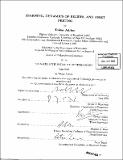| dc.contributor.advisor | Olivier J. Blanchard, Xavier Gabaix and Stephen A. Ross. | en_US |
| dc.contributor.author | Adrian, Tobias, 1971- | en_US |
| dc.contributor.other | Massachusetts Institute of Technology. Dept. of Economics. | en_US |
| dc.date.accessioned | 2005-06-02T16:13:43Z | |
| dc.date.available | 2005-06-02T16:13:43Z | |
| dc.date.copyright | 2003 | en_US |
| dc.date.issued | 2003 | en_US |
| dc.identifier.uri | http://hdl.handle.net/1721.1/17571 | |
| dc.description | Thesis (Ph. D.)--Massachusetts Institute of Technology, Dept. of Economics, 2003. | en_US |
| dc.description | Includes bibliographical references (p. 130-139). | en_US |
| dc.description.abstract | In the first chapter, I study the impact of statistical arbitrage on equilibrium asset prices. Arbitrageurs have to learn about the long-run behavior of the stock price process. They condition their investment strategy on the observation of price and volume. The learning process of the statistical arbitrageurs leads to an optimal trading strategy that can be upward sloping in prices. The presence of privately informed investors makes the equilibrium price dependent on the history of trading volume. The response of prices to news is nonlinear, and little news can have large effects in some ranges of the prices. In the second chapter, together with Francesco Franzoni, we develop an equilibrium model of learning about time-varying risk factor loadings. In the model, CAPM holds from investors' ex-ante perspective. However, positive mispricing can be observed when investors' expectations of beta are above ex-post realizations. This model is used to explain the 'value premium'. In a learning framework, the fact that value stocks used to be more risky in the past leads to investors' expectations of beta that exceed the estimates from more recent samples. We propose an empirical methodology that takes investors' expectations of the factor loadings explicitly into account when estimating betas. With the adjusted estimates of beta, we can explain the cross-section of average returns of the ten book-to-market portfolios, and account for the value premium in the relevant sample. The third chapter investigates the role of contagion during the Great Depression. The Great Depression was a worldwide phenomenon, accompanied by financial crisis. I investigate whether financial contagion contributed to the spread of the Great Depression across countries. Contagion happens when idiosyncratic shocks are transmitted from one country to another. | en_US |
| dc.description.abstract | (cont.) Asset price movements in the country affected by contagion are not justified by its own fundamentals. Contagion leads to an increase in the covariance of international financial markets during periods of financial crisis. Two particular events are tested: the stock market crash of 1929 and the Latin American debt crises of 1931. In both events the hypothesis that the crises spread contagiously is rejected with one exception: the French Stock Market. | en_US |
| dc.description.statementofresponsibility | by Tobias Adrian. | en_US |
| dc.format.extent | 139 p. | en_US |
| dc.format.extent | 4647112 bytes | |
| dc.format.extent | 4646916 bytes | |
| dc.format.mimetype | application/pdf | |
| dc.format.mimetype | application/pdf | |
| dc.language.iso | eng | en_US |
| dc.publisher | Massachusetts Institute of Technology | en_US |
| dc.rights | M.I.T. theses are protected by copyright. They may be viewed from this source for any purpose, but reproduction or distribution in any format is prohibited without written permission. See provided URL for inquiries about permission. | en_US |
| dc.rights.uri | http://dspace.mit.edu/handle/1721.1/7582 | |
| dc.subject | Economics. | en_US |
| dc.title | Learning, dynamics of beliefs, and asset pricing | en_US |
| dc.type | Thesis | en_US |
| dc.description.degree | Ph.D. | en_US |
| dc.contributor.department | Massachusetts Institute of Technology. Department of Economics | |
| dc.identifier.oclc | 52873237 | en_US |
